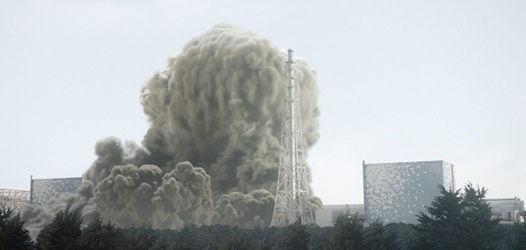
On March 12, 2011, a hydrogen explosion occurred at the first nuclear power plant in Fukushima, causing white smoke to rise. Central photo
On March 11, 2011, ten years ago, a tsunami caused by the Great East Japan Earthquake struck the Fukushima nuclear power plant on the Pacific coast. As the power supply to the nuclear power plant was cut off, it was not possible to cool the nuclear fuel inside the nuclear power plant, leading to an explosion, and eventually a large amount of radioactivity was leaked.
At the time of the Great East Japan Earthquake, about 16,000 people died, and 3,500 people died from the Fukushima nuclear power plant. However, unlike earthquakes and tsunamis, damage caused by radiation exposure lasts for a long time.
In a report published on the 4th, Greenpeace, an international environmental group, in the 10th year of the Fukushima nuclear accident, said in a report published on the 4th, “Due to the nuclear disaster, residents have lost their hometown, family, community, health and property without any fault.”
① 36,192 residents who are still evacuated + @

On the afternoon of the 3rd, various wastes are piled up at the’Specific Waste Storage Center’ in the area of difficulty returning to Tomioka-machi, Fukushima Prefecture, Japan. Here, after an explosion accident occurred at the Fukushima Daiichi Nuclear Power Plant in March 2011, residents evacuated and then temporarily stored wastes that were removed from various facilities in the area. yunhap news
Although 10 years have passed, more than 30,000 refugees remain in the aftermath of the nuclear accident. At the time of the 2011 accident, 164,000 refugees occurred. As of January 2021, 36,192 people were still evacuated in and outside Fukushima Prefecture. This is a count of only those who have left their residence at the order of the Japanese government. Those who escaped their own danger and went far away were not included.
From December 2011, the early days of the accident, even though they were not in an evacuation area, some expenses were provided to residents who voluntarily migrate to avoid danger, but the number of refugees officially counted has decreased significantly, Greenpeace said. The last recorded’voluntary refugees’ in 2017 was 1,524 households and 26,601.
Suzuki Kazue Greenpeace Japan Campaigner said, “There are actually people who are evacuating, but administratively classifies them as non-refugees. This is a violation of the UN’s “Protection Principles on Domestic Refugees”” he criticized.
Greenpeace also pointed out in the report that “the Japanese government is using every means to force refugees to return.” The radiation dose, estimated by the World Atomic Energy Agency (IAEA) and the World Health Organization (WHO), is 1mSv (millisievert) per year, which is estimated to have no significant health problems even if the public is exposed. However, the Japanese government canceled the evacuation order based on 20mSv, saying, “It’s okay up to 20mSv per year.”
② Accumulated 30 million workers to remove radioactive contamination… Keep increasing

On the 6th, a black bag containing radioactive soil and grass is piled up in Idate-mura, Fukushima Prefecture. Correspondent Yoon Seol-young
By 2018, more than 30 million people were involved in decontamination (decontamination) at the Fukushima nuclear power plant and surrounding areas. The decontamination work of a nuclear power plant accident requires a large number of personnel because one person cannot work for a long time due to strong radioactivity, and more people have to be put in a short time shift.
Last year, the UN Special Rapporteur for Human Rights was concerned, “Most of the workers involved in the decontamination work belong to subcontractors, and they are likely to be exposed to dangerous environments because of lack of protective equipment and lack of education on the risk of exposure.” Greenpeace pointed out that “in the Namie area designated as a difficult-to-return area, it has been confirmed that decontamination workers have been exposed to high-level radiation, and if the decontamination is expanded to a stronger radioactive contaminated area, workers will be put into a more dangerous work environment.”
③ People living in’return difficult areas’

A rockfish caught in the sea in front of Fukushima. The shipment of this species has been stopped as radioactive substances more than five times the Japanese government’s standard were released from the rockfish. yunhap news
Due to the severe degree of radioactive contamination, people now live in areas designated as’return difficult areas’. As of January 2021, 1579 out of 16,681 registered population live in Nami, and 1,255 out of 6509 registered population live in Itate. The Japanese government, which designated seven districts in Fukushima Prefecture, including Namie and Itate, as “return difficult areas,” plans to release all of them by 2023.
On the other hand, Greenpeace saw that it would be difficult for residents to return safely for the next several decades because the decontamination plans in the areas having difficulty returning home were insufficient. “The radioactive damage after the nuclear power plant accident is still in its infancy, and it is an obvious falsehood that the government says,’Since the decontamination has been completed, residents can return.’” (Kazue Suzuki Camper) is a criticism.
Greenpeace Jangmari Climate Energy Camper said, “Some people are asking,’Do you still talk about 10 years ago?’, but even now, radioactive hot spots that are more than tens of times the standard are still being discovered around Fukushima. “It is proof that it is impossible to correct the accident right away.” He said, “The (full-scale) damage caused by the nuclear power plant accident starts now,” he said. “In order not to pass on the risk to the next generation, the Japanese government must withdraw the decision to discharge contaminated water and the unrealistic decommissioning plan,” he said.
Reporter Kim Jeongyeon [email protected]
![]()
